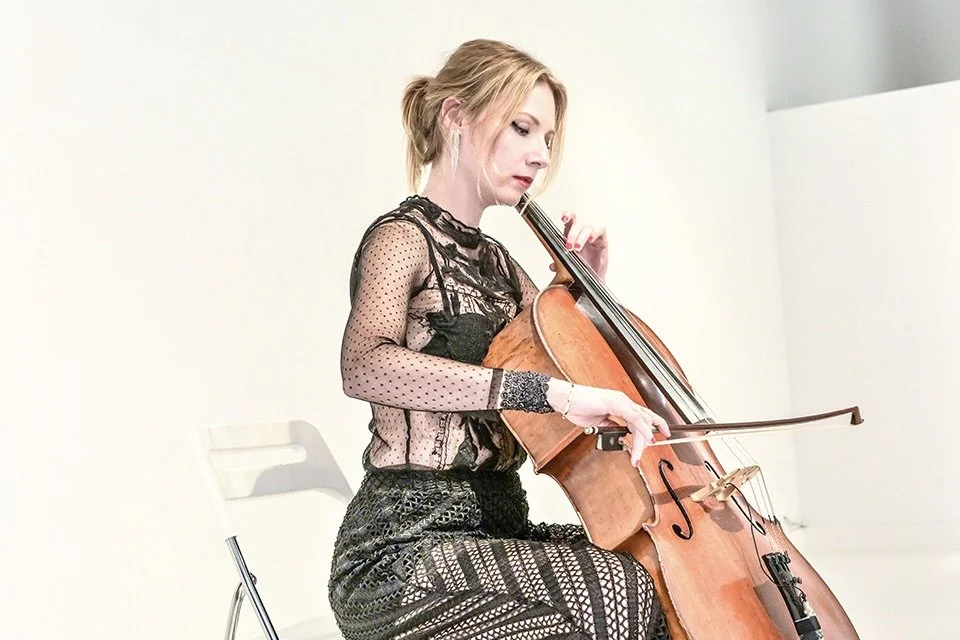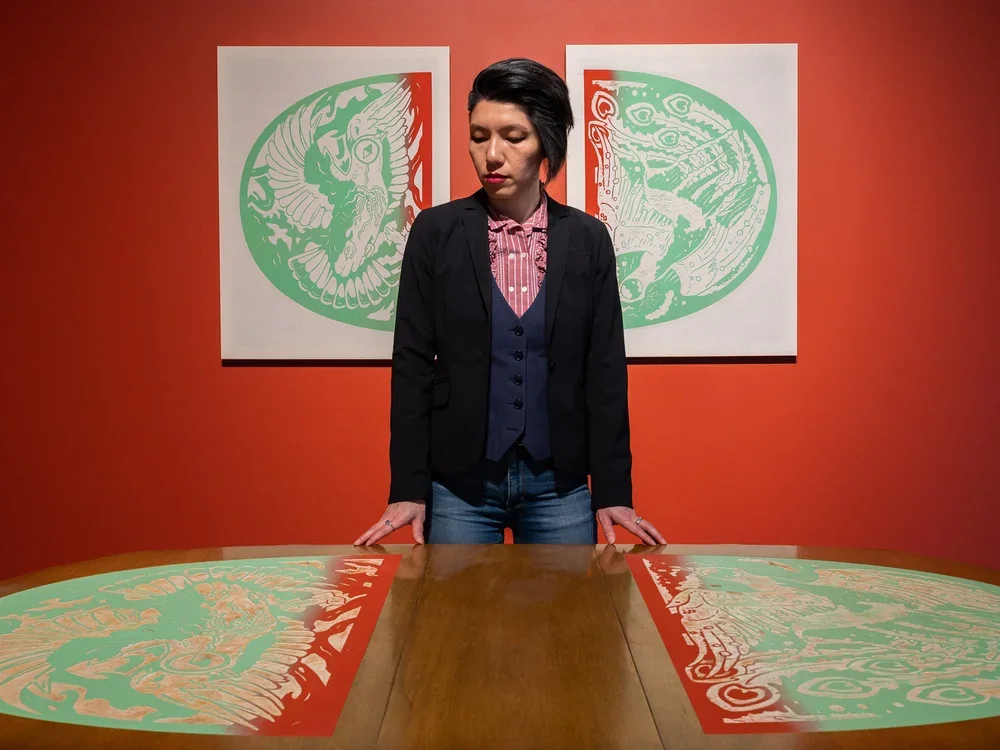Glossy fruit and ghostly dresses, as Gathie Falk: Revelations looks back on art that uplifts the ordinary
In vivid retrospective at Audain Art Museum, themes of mortality hover beneath the visual splendour
Gathie Falk’s 2010-11 work The Problem with Wedding Veils, in papier-mâché and rocks. Collection of the artist. Photo courtesy of Equinox Gallery/Scott Massey ©Gathie Falk
Gathie Falk’s Cabbages installation at the Audain Art Museum. Photo by Oisin McHugh Photography
Gathie Falk: Revelations is at the Audain Art Museum to May 6, 2024
VANCOUVER ARTIST Gathie Falk has called her work a “veneration of the ordinary”—and there’s no better example than the lowly cabbage lifted up to new heights in an expansive new retrospective showing at Whistler’s Audain Art Museum.
Eighteen of the humble crucifers have been rendered in green-glazed ceramic, leaf by meticulous leaf. The vegetable would have been a staple in her diet growing up in a Russian-Mennonite family in rural Manitoba, but Falk has always pushed against such direct biographical readings of her work. Here they transcend their earthly use, each at a different stage of ripeness, suspended by fishing wire and floating ethereally in the air like strange celestial bodies. It’s a surreal cabbage cosmos.
In Revelations, organized by the McMichael Canadian Art Collection and drawn from public galleries and private collectors, the celebrated Canadian artist brings the same sense of wonder to pyramid-shaped piles of shiny ceramic apples and grapefruits; vivid paintings of sidewalk cement; a seminal performance-art video that centres on an old-school wringer washing machine; and shoes lovingly crafted from clay.
The retrospective is a creatively organized ode to the major themes of an artist whose awards include the Order of Canada and the Audain Prize for Lifetime Achievement in the Visual Arts.
Charting the 95-year-old’s work from the 1960s to the 2000s, and arranged across several expansive rooms at the Audain, the show captures the religiously devout Falk’s extraordinary way of seeing the world around her. Punctuated with bright hues of orange and red, it’s an exhibition that’s full of joy and humour—though darker themes of mortality hover just beneath the upbeat surfaces.
Beautifully curated by Sarah Milroy (who organized the equally revelatory Uninvited: Canadian Women Artists in the Modern Moment at the Vancouver Art Gallery this year), the exhibition starts with a vast room of some of Falk’s best-known works: richly coloured ceramic-fruit piles, each piece handmade with different dimples and indentations. Arranged in perfect pyramid formations, these early-1970s works were partly inspired by the fruit displays she saw at corner grocery stores. They also speak to a larger fascination with food ceremony from her domestic life growing up in her Mennonite household, the daughter of parents who fled Russia after the 1917 revolution. They’re voluptuous, glossy, and celebratory; but look toward one apple pile, where brilliant red gradually turns black as you move downward—a whispering of decay and death amid the bounty.
Gathie Falk’s Eight Red Boots from 1973, red-glazed ceramic in painted plywood and glass cabinet, from the National Gallery of Canada, Ottawa. Photo by NGC ©Gathie Falk
Gathie Falk’s 18 Pairs of Red Shoes With Roses, installation view, at the Audain Art Museum. Photo by Oisin McHugh Photography
Equally vibrant is another room featuring her cases of ceramic men’s shoes from the early 1970s—each painstakingly cut and formed from clay that was rolled to the thickness of leather. They hearken back to Falk’s early years supporting her widowed mother in fabrication work on factory assembly lines; when the two moved to the West Coast in the late ’40s, Falk’s first job was at a luggage factory. The shoes also reveal the sublime in the everyday. Single Right Men’s Shoes: Bootcase With 6 Orange Brogues features the sextet of well-worn men’s footwear in a glass showcase, each occupying its own shelf, in jaunty, glossy orange glaze. The modest shoes are displayed with an almost altar-like respect. Look closely at 1973’s 18 Pairs of Red Shoes With Roses, repeating across a long platform that dominates the centre of the room, and you’ll see laces at different stages of done and undone. Each has different, personalized creases where their wearer bent their foot walking. They speak of the body and presence, a life of work—but also a haunting absence.
A much more unsettling piece of apparel comes to life in one of the exhibition’s centrepieces, 2010-11’s The Problem With Wedding Veils. The papier-mâché sculpture of an intricately pleated wedding veil, topped with a treacherously serrated crown and flowing into a long train, hovers upright—unoccupied and ghostlike, at an uneasy diagonal. Walk around it and you’ll see two heavy brown rocks weighing down the end of the veil’s train. It would seem to be a surreal and deeply feminist statement on the burdens of matrimonial duty in Falk’s lifetime—though the artist has famously insisted the rocks serve only to keep the veil from falling over. How much of a “problem” you read into this surreal and striking work may have to do with your experience of marriage as an institution.
Papier-mâché appears again in 1999’s Reclining Figure (After Henry Moore): Stella, this time in the form of a white dress, with a pleated skirt floating upward. Haunting and ghostly beautiful, it feels as light as air compared to Reclining Figure (after Henry Moore): Lizzie. The black-bronze version of a similar dress feels dense, dark, and heavy, with one invisible knee raised enigmatically, perhaps rebelliously, through the pleats—memorializing a friend who had died. Here, at the end of the exhibition, the theme of absence is more visceral. Heightening ideas of mortality and existence are the fiercely glowing paintings of night skies that surround the dresses. We have gradually moved from glistening fruit to lightly worn shoes to larger meditations on life and death. Look closely at the stars glowing at different heights in Heavenly Bodies Again #20, and you’re reminded of that cabbage cosmos.
That Falk’s vast output of work, with its array of media, so fluidly connects the earthly with the heavens is one of the biggest wonders—the revelations—of this essential show.
Gathie Falk’s 14 Grapefruits, from 1970, in ceramic. Photo by Rachel Topham Photography ©Gathie Falk

















